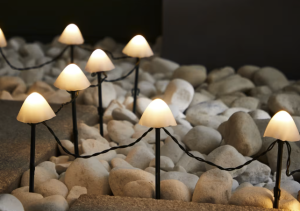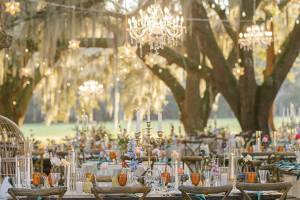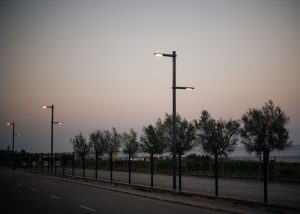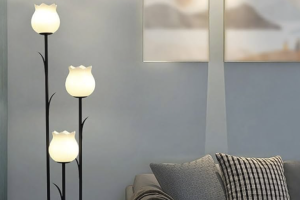Enhancing Your Home’s Ambiance with Outdoor Lighting
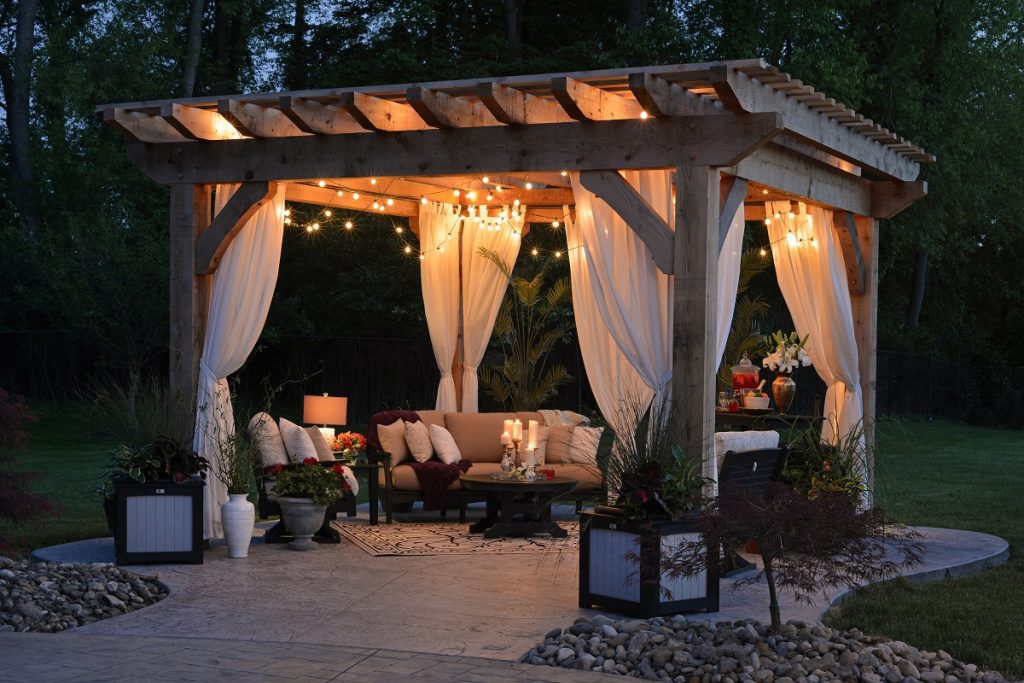
Outdoor lighting is an essential aspect of any home’s design. It not only enhances the aesthetic appeal of your property but also serves functional purposes such as providing safety and security. Whether you want to highlight your home’s architecture, create a welcoming entryway, illuminate outdoor living spaces, enhance security, or showcase your landscaping and garden features, outdoor lighting can help you achieve these goals.
The benefits of outdoor lighting are numerous. Firstly, it adds beauty and ambiance to your home’s exterior. Well-placed lights can highlight architectural details, create focal points, and set the mood for outdoor gatherings or relaxation. Secondly, outdoor lighting improves safety by illuminating pathways, stairs, and other potential hazards. It helps prevent accidents and ensures that you and your guests can navigate your property safely at night. Lastly, outdoor lighting enhances security by deterring potential intruders. A well-lit exterior can make your home less attractive to burglars and provide peace of mind for you and your family.
Types of Outdoor Lighting: Choosing the Right Fixtures for Your Home
When it comes to outdoor lighting zangkao fixtures, there are various options to choose from. Each type serves a specific purpose and can contribute to the overall design of your home’s exterior. Some common types of outdoor lighting fixtures include:
1. Wall-mounted lights: These fixtures are attached to the exterior walls of your home and provide general illumination for entryways, patios, or decks.
2. Path lights: Path lights are typically low-level fixtures that are installed along walkways or driveways to guide people safely at night.
3. Spotlights: Spotlights are used to highlight specific architectural features or landscape elements such as trees, statues, or water features.
4. Floodlights: Floodlights are powerful fixtures that provide broad illumination over a large area. They are often used for security purposes or to light up large outdoor spaces.
5. String lights: String lights are a popular choice for creating a festive and cozy ambiance. They can be hung across patios, pergolas, or trees to add a warm glow to your outdoor living spaces.
When choosing outdoor lighting fixtures, there are several factors to consider. Firstly, consider the purpose of the lighting. Are you looking to create a specific ambiance, enhance security, or highlight certain features? Secondly, consider the style and design of your home. Choose fixtures that complement the architectural style and color scheme of your property. Lastly, consider the practical aspects such as energy efficiency and maintenance requirements. Opt for LED lights, which are energy-efficient and have a longer lifespan compared to traditional incandescent bulbs.
Planning Your Outdoor Lighting: Tips for a Cohesive Design
Planning is crucial when it comes to outdoor lighting. A well-thought-out design will ensure that your lighting fixtures work together harmoniously and achieve the desired effect. Here are some tips for planning a cohesive outdoor lighting design:
1. Determine your goals: Before you start planning, identify what you want to achieve with your outdoor lighting. Do you want to create a dramatic effect, provide functional illumination, or both? Knowing your goals will help guide your design decisions.
2. Create a lighting plan: Start by sketching out your property and marking the areas where you want to install lighting fixtures. Consider pathways, entryways, outdoor living spaces, architectural features, and landscaping elements that you want to highlight.
3. Consider layers of light: To create depth and visual interest, incorporate different layers of light in your design. Use a combination of ambient, task, and accent lighting to achieve the desired effect.
4. Use different light sources: Experiment with different types of light sources such as spotlights, wall-mounted lights, or string lights to create variety and add dimension to your outdoor lighting design.
5. Test the lighting effects: Before finalizing your design, test the lighting effects at night. This will help you identify any areas that need adjustment and ensure that the overall design achieves the desired effect.
Highlighting Your Home’s Architecture with Outdoor Lighting
One of the most effective ways to enhance the beauty of your home’s exterior is by highlighting its architecture with outdoor lighting. By strategically placing lights, you can draw attention to architectural details, create a focal point, and add depth and dimension to your property. Here are some techniques for highlighting your home’s architecture with outdoor lighting:
1. Up-lighting: This technique involves placing lights at the base of your home’s exterior walls and directing the light upwards. It creates a dramatic effect by highlighting the texture and shape of the walls.
2. Grazing: Grazing involves placing lights close to the surface of a textured wall or facade to create interesting shadows and highlights. This technique adds depth and visual interest to your home’s exterior.
3. Silhouetting: Silhouetting is achieved by placing lights behind architectural features such as columns or statues to create a striking silhouette against the backdrop of your home’s exterior.
4. Wash lighting: Wash lighting involves using floodlights or wall-mounted lights to evenly illuminate a large area such as a facade or a wall. It creates a soft and uniform glow that enhances the overall appearance of your home.
5. Accent lighting: Accent lighting is used to highlight specific architectural details such as columns, arches, or decorative elements. By focusing light on these features, you can draw attention to their beauty and uniqueness.
When implementing these techniques, it’s important to consider the scale and proportion of your home’s architecture. Use lights that are appropriate in size and intensity to ensure that they complement rather than overpower the overall design.
Creating a Welcoming Entryway with Outdoor Lighting
The entryway is the first impression visitors have of your home, and outdoor lighting plays a crucial role in creating a welcoming and inviting atmosphere. By illuminating the pathway, front door, and surrounding areas, you can enhance the curb appeal of your home and make guests feel safe and comfortable. Here are some tips for creating a welcoming entryway with outdoor lighting:
1. Pathway lighting: Install path lights along the walkway leading to your front door to guide visitors safely at night. Choose fixtures that are low-level and provide a warm and inviting glow.
2. Front door lighting: Install a wall-mounted light or pendant light near your front door to provide ample illumination for guests to find their way. Choose a fixture that complements the style of your home’s architecture and adds a touch of elegance.
3. Accent lighting: Use accent lighting to highlight architectural features such as columns, arches, or decorative elements near your entryway. This will add visual interest and draw attention to the unique characteristics of your home.
4. Landscape lighting: Incorporate landscape lighting around your entryway to create a cohesive design. Use lights to highlight trees, shrubs, or flower beds, and consider adding up-lighting or down-lighting to create a dramatic effect.
5. Consider motion sensor lights: Motion sensor lights can be a practical addition to your entryway. They automatically turn on when someone approaches, providing added security and convenience.
By carefully selecting and placing outdoor lighting fixtures, you can create an inviting entryway that sets the tone for the rest of your home.
Illuminating Your Outdoor Living Spaces for Entertaining and Relaxation

Outdoor living spaces such as patios, decks, or gardens are extensions of your home where you can entertain guests or relax with family and friends. Proper illumination is essential to make these spaces functional and enjoyable after dark. Here are some tips for illuminating your outdoor living spaces:
1. Ambient lighting: Start by providing general illumination for the entire space. This can be achieved through overhead fixtures such as pendant lights, chandeliers, or ceiling fans. Choose fixtures that are weather-resistant and provide a warm and inviting glow.
2. Task lighting: Task lighting is important for specific activities such as cooking, reading, or playing games. Install lights near cooking areas, seating areas, or game tables to ensure that these areas are well-lit and functional.
3. Accent lighting: Use accent lighting to create focal points and add visual interest to your outdoor living spaces. This can be achieved through the use of spotlights, string lights, or lanterns. Consider highlighting architectural features, water features, or landscaping elements to create a magical ambiance.
4. Dimmers and controls: Install dimmers and controls to adjust the intensity of the lighting according to your needs. This allows you to create different moods and atmospheres depending on the occasion.
5. Consider fire features: Fire features such as fire pits or fireplaces not only provide warmth but also add a cozy and inviting glow to your outdoor living spaces. Combine fire features with appropriate lighting to create a magical ambiance.
By carefully planning and selecting the right lighting fixtures, you can transform your outdoor living spaces into functional and inviting areas for entertaining and relaxation.
Enhancing Your Home’s Security with Outdoor Lighting
Outdoor lighting plays a crucial role in enhancing the security of your home. A well-lit exterior can deter potential intruders and provide peace of mind for you and your family. Here are some tips for enhancing your home’s security with outdoor lighting:
1. Install motion sensor lights: Motion sensor lights automatically turn on when they detect movement, providing a deterrent to potential intruders. Install them near entryways, garages, or other vulnerable areas of your property.
2. Use floodlights for large areas: Floodlights provide broad illumination over a large area and can help deter intruders by eliminating hiding spots. Install them in areas such as driveways, backyards, or side yards.
3. Illuminate dark corners: Dark corners or blind spots can provide hiding places for intruders. Install lights in these areas to eliminate shadows and make your property less attractive to burglars.
4. Use timers or smart lighting controls: Timers or smart lighting controls can be programmed to turn on and off lights at specific times, giving the impression that someone is home even when you’re away. This can deter potential intruders who may be monitoring your property.
5. Consider security cameras: Security cameras can be integrated with your outdoor lighting system to provide an extra layer of security. They can capture footage of any suspicious activity and help identify potential intruders.
By strategically placing outdoor lighting fixtures and using technology such as motion sensors and timers, you can enhance the security of your home and create a safer environment for you and your family.
Using Outdoor Lighting to Highlight Landscaping and Garden Features
Outdoor lighting is a powerful tool for showcasing the beauty of your landscaping and garden features. By strategically placing lights, you can create a magical ambiance, highlight the unique characteristics of your plants and flowers, and extend the enjoyment of your outdoor spaces into the evening hours. Here are some tips for using outdoor lighting to highlight landscaping and garden features:
1. Pathway lighting: Install path lights along garden pathways to guide visitors and create a safe and inviting atmosphere. Choose fixtures that are low-level and provide a warm and gentle glow.
2. Up-lighting: Use up-lighting to highlight trees, shrubs, or other tall plants in your garden. This technique creates a dramatic effect by casting light upwards and illuminating the canopy or foliage.
3. Down-lighting: Down-lighting involves placing lights high above the ground to cast a soft and diffused light downwards. This technique is ideal for highlighting ground covers, flower beds, or low-growing plants.
4. Silhouetting: Silhouetting can be used to create a striking effect by placing lights behind plants or garden features to create a silhouette against the backdrop of your property. This technique adds depth and visual interest to your garden.
5. Water feature lighting: If you have a pond, fountain, or waterfall in your garden, consider adding underwater lights or spotlights to highlight these features. The reflection of light on the water creates a magical and tranquil ambiance.
When using outdoor lighting to highlight landscaping and garden features, it’s important to strike a balance between illumination and darkness. Avoid over-lighting your garden, as this can create a harsh and unnatural effect. Instead, aim for a subtle and soft glow that enhances the beauty of your plants and flowers.
Energy-Efficient Outdoor Lighting Options: Saving Money and the Environment
In today’s environmentally conscious world, energy-efficient outdoor lighting options are becoming increasingly popular. Not only do they help reduce energy consumption and lower utility bills, but they also have a positive impact on the environment. Here are some energy-efficient outdoor lighting options:
1. LED lights: LED lights are highly energy-efficient and have a longer lifespan compared to traditional incandescent bulbs. They consume up to 80% less energy and can last up to 25 times longer. LED lights are available in various colors and intensities, making them suitable for a wide range of outdoor lighting applications.
2. Solar-powered lights: Solar-powered lights harness energy from the sun during the day and use it to power the lights at night. They are easy to install and require no wiring or electricity. Solar-powered lights are ideal for pathways, gardens, or other areas where access to electricity is limited.
3. Low-voltage lighting: Low-voltage lighting systems operate on 12 volts instead of the standard 120 volts used in traditional lighting systems. They consume less energy and are safer to install and maintain. Low-voltage lighting is ideal for illuminating pathways, gardens, or other outdoor areas.
4. Motion sensor lights: Motion sensor lights only turn on when they detect movement, reducing energy consumption by only providing illumination when needed. They are ideal for security purposes or areas where lighting is required intermittently.
5. Timers and controls: Timers and controls allow you to program the on and off times of your outdoor lighting fixtures. This ensures that lights are only on when needed, reducing energy waste and lowering utility bills.
By opting for energy-efficient outdoor lighting options, you can save money on your energy bills and reduce your carbon footprint, contributing to a more sustainable future.
DIY Outdoor Lighting Projects: Adding Personal Touches to Your Home’s Ambiance
If you’re feeling creative and want to add a personal touch to your home’s ambiance, DIY outdoor lighting projects are a great option. Not only do they allow you to customize your lighting design, but they also provide a sense of accomplishment and satisfaction. Here are some DIY outdoor lighting projects:
1. Mason jar lanterns: Mason jar lanterns are a popular DIY project that adds a rustic and charming touch to your outdoor spaces. Simply insert a candle or LED light into a mason jar, decorate it with ribbons or twine, and hang it from trees or pergolas.
2. Wine bottle torches: Wine bottle torches are an elegant and unique way to illuminate your outdoor spaces. Simply insert a wick into an empty wine bottle filled with lamp oil or citronella oil. The wick will absorb the oil and provide a steady flame that can last for hours. These torches not only provide ambient lighting, but they also help to repel insects with the citronella oil. The flickering flame adds a touch of romance and sophistication to any outdoor gathering or event. Wine bottle torches are easy to make and can be customized to match your personal style by using different colored bottles or adding decorative elements such as ribbons or beads. Whether you’re hosting a backyard barbecue or enjoying a quiet evening on the patio, wine bottle torches are a beautiful and functional addition to your outdoor decor.


